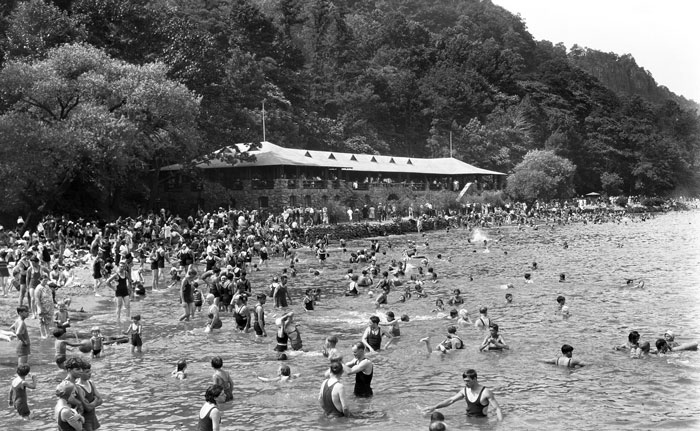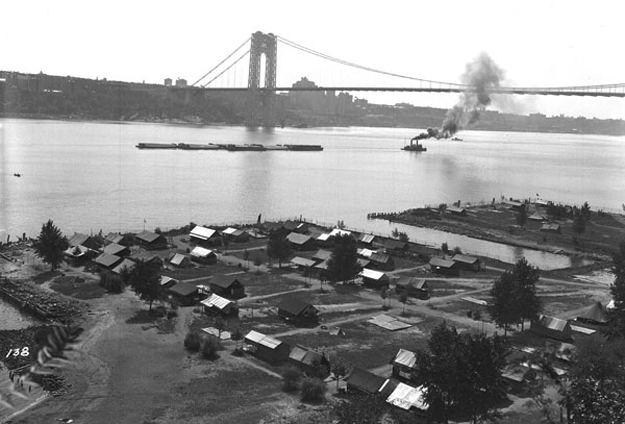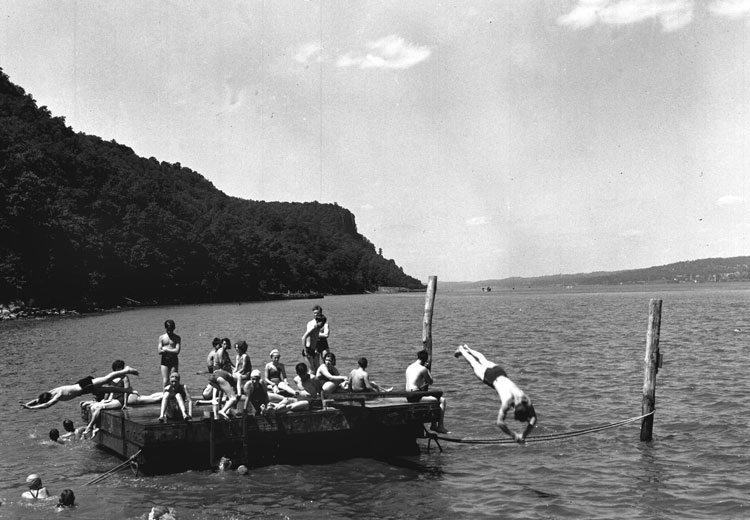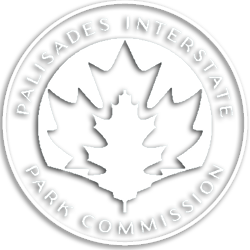The “Mystery” of the Beaches
A “Cliff Notes” Story
July 1998
The year 1932 is one of our favorites for park history, if only because — for whatever reason — it was a busy one for park photographers. They took dozens of shots in the park, showing our facilities running at an unbelievable full tilt, including several Hudson River bathing beaches.
We recently dug out the park’s annual report for 1932, just to have some words to go with the pictures…
According to the report, over two million visitors came to the Palisades that year, including a good-sized army’s worth of bathers. An estimated 130,000 used the big bath houses at Hazard’s Beach or at Undercliff, while another 210,000 used the “smaller dressing rooms” at Bloomers, Alpine, and Quinn’s beaches. “Besides these, there were many persons who did not use the bath houses, but who came to the Park in bathing suits and removed their outer wraps upon arrival…”

Park lifeguards would rescue a dozen persons from drowning and “several cases were treated for submersion and 67 given first aid treatment.” Happily, “no lives were lost at the beaches.”
Ross Dock, meanwhile, was “home” to some three thousand campers — though they didn’t quite have to rough it. “Ross Dock Camp is equipped with many conveniences such as city water, hot and cold showers, sanitary sewerage … a rustic cabin housing the resident camp manager and camp store. The entire area, including private bathing beach, is enclosed by strong wire fence, thus excluding the general public…”

As fascinating as all this was, it began to get us thinking. We knew that within a decade, each of our bustling bathing beaches would in turn be abandoned. Just how did that come about? The obvious, somewhat pat answer is of course “pollution.” But as with so many things “obvious,” we wondered if this one couldn’t stand a closer look. Those of us living in the area, after all, have become inured to the idea that the Hudson River is “polluted.” But just how does a body of water apparently clean enough to accommodate hundreds of thousands of bathers become — in a scant decade — unsafe to swim?
It was back to the file cabinet drawer where the annual reports are kept, to do some historical “beach combing.” Here’s an abbreviated chronology of what we found.
1933
For the first time, an admission fee got charged at the park’s public beaches, 10 cents for anyone over twelve. The reason: the park had been losing revenue from its ferry operations ever since the George Washington Bridge opened two years back. Some 97,017 persons opted to pay this fee, while “it is estimated that almost 300,000 children also used the beaches without charge.”
1936
Admission was still 10 cents, but the numbers dropped to 59,703 paid and about 180,000 children, with a revenue drop of 21 percent from the previous year. “It is believed that the numerous new pools in New York City attracted many who formerly bathed at the Palisades beaches.”
1938
“Only three bathing areas were open to the public during 1938, those at Bloomers, Undercliff and Alpine. Hazards, at the southern end of the park, was not opened, due to the lack of direct ferry service from New York City.” The missing ferry was a passenger-only boat that had run from 158th Street to Carpenter’s Landing, crossing the river literally in the shadow of the bridge that would spell its demise. Yet the total number of bathers remained almost the same as in 1936.
1941
“1941 income amounted to $5,211.25, a loss of $855.70 from last season’s revenue. This was probably due to weather conditions — lack of prolonged heat waves and cooler weekends — and the tendency of people to patronize more costly places when money is freer.” The economy had gradually improved since the start of the Great Depression — and people were traveling farther from home. Without explanation, the Undercliff Beach was no longer listed in the report, leaving just two beaches, Bloomer’s and Alpine.
1942
America had entered the World War. The venerable Dyckman Street-Englewood Ferry finally succumbed to competition from the bridge, and as a result, Bloomer’s Beach saw a 60 percent drop in income; Alpine was up slightly. It was the tenth year without a fatality at the beaches.
1943
“The Bloomers Area was not open … due to curtailed passenger car use and because the Dyckman Street Ferry did not operate.” Alpine saw a 33 percent increase in attendance. “This increase may have been accounted for by the desire of the public to gain respite from war strains, and the fact that the beach was accessible to those restrained by the war from the customary use of their automobiles for longer distances.” (War-effort gasoline rationing had gone into effect.)
1944
“The Alpine bathing area was closed for bathing for the duration, because of river pollution caused by war conditions.” The first and only mention of the word — and then it was dropped like a cannonball on the page.
What are we to make of it? To be sure, there are plenty of holes in our story, based as it is on a single source (the annual reports). Still, we can see that it was in truth a host of causes, from the George Washington Bridge to new city pools, that helped close the beaches. “Pollution” was the final of these.
As a general rule, while the economy sagged, people came to the beaches; when an upturn occurred, they tended to head to destinations farther from home. So it was that during the Depression, our beaches offered affordable recreation close to home for hundreds of thousands, most of them New Yorkers who came on the ferry services. (This was also a time when a great deal of heavy industry — along with its waste pipes — was closed down due to the weak economy.) When the George Washington Bridge opened in 1931, it would put a dire crimp in ferry service. In one year, the Dyckman Ferry went from taking over a million vehicles down to 300,000. The 158th Street passenger boat struggled along for several years before going belly up, and then the first of our beaches, Hazard’s, had to close.
World War II brought a whole new set of complex variables to the equation, everything from “war strains” to gasoline rationing. The gargantuan war effort would also produce massive amounts of industrial waste — and so went Alpine, the last of our beaches.

It is perhaps crucial at this point to note how knowledge of water quality issues has grown in the decades since, and that the Hudson has as a result undergone a profound recovery. Experts say our section of the river is today on the very verge of being clean enough to swim again. Part of what’s intriguing about this is the thought that the river was probably already polluted — by today’s standards — before the war. We simply had neither the understanding of water quality we have today, nor the technical means to test for it. (Remember that most water pollution is invisible; to the thousands at our beaches, the river may have seemed clean enough.) So when children can once again jump safely into the water of the Hudson, that water will likely be cleaner than the water of six decades ago, back during the Great Depression — back when our bathing beaches boomed.
– Eric Nelsen –

